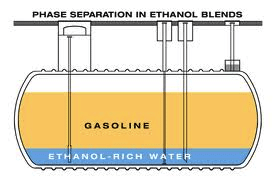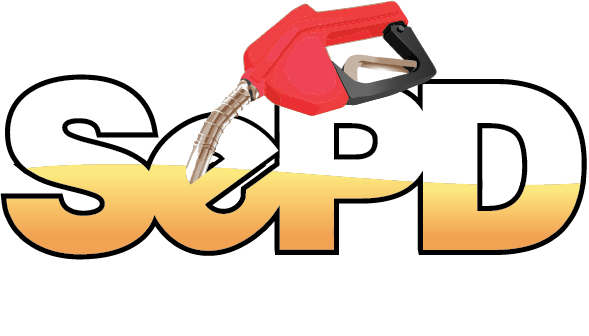Water & Phase Separation in Gasoline-Ethanol Blends (E10)
What is Phase Separation? Water contamination in any underground storage tank (UST) can lead to fuel quality issues, but due to water’s solubility properties, it can cause particularly serious problems in USTs containing gasoline-ethanol blends (such as E10). When water is introduced into a tank containing a gasoline-ethanol blend, it can lead to an issue known as phase separation. Phase separation occurs when water latches on to the ethanol in the gasoline, and extracts it down to the bottom of the tank. This results in two distinct layers (Figure 1):
- The ethanol-depleted gasoline on top may be hazy due to suspended water.
- The water-ethanol mixture is heavier and has separated to the bottom of the tank. It may look murky if the underground storage tank (UST) is dirty.

Figure 1 (From Tankology)
The water-ethanol layer that forms during a phase separation could be several inches in depth, enough to reach the suction of the pump and then be dispensed into a vehicle, potentially resulting in vehicle problems. A common misconception of site owners is that water problems only happen when multiple consumer complaints are received. This is not true – phase separation can and does happen to single motorists, and in some cases, they might not notice the effects immediately. It is also important to note that continuing to dispense the top layer of ethanol-deficient fuel poses problems as well. It has reduced octane, which could result in engine knocking.
The product also may not meet regulatory standards due to its insufficient ethanol content or related changes to vapor pressure.
Preventing Phase Separation
Water can enter a fuel storage system via many different avenues: product delivery mishaps or UST leaks from damaged or malfunctioning gaskets, fittings, or any place that is not water tight. It is possible for water entering the storage tank to initially seep to the bottom without causing an issue, but a phase separation may be triggered by a delivery, when the fuel and water undergo turbulent mixing. The occurrence of phase separations can be minimized by preventing water contamination downstream of the terminal. It is important to be diligent about monitoring for water. See our Water and Phase Separation Guidelines for Retail Gas and Convenience Stores for more detailed instructions.
Water Absorbing Shut-Off Filters
Installing water-absorbing shut-off filters can help prevent dispensing phased-separated fuel. The dispenser filters may become blocked or partially blocked, leading to slow flow of product from the dispenser or even inoperable dispensers. These may help warn you of a water-related issue and keep separated fuel from reaching the consumer.
Automatic Tank Gauging Systems
It is important to use the proper tank gauging system and to periodically inspect your gauge for cleanliness.
Most older automatic tank gauging (ATG) systems were designed for use in straight non-ethanol gasoline, so they often overlook a phase separation in E10 gasoline blends. These older water floats used buoyancy to indicate the height of the water bottom phase, if existent. However, this design has not been successful in E10 gasoline. In tanks containing phase separated E10, the water bottom is rich in ethanol and is less dense than a bottom layer containing only water. In this case, a float will sink to the bottom of the tank and offer no indication of a substantial bottom layer, and the phase separation will not be detected.
There are modern gauging systems available to help detect water in ethanol-blended gasolines. Veeder-Root has designed a Phase II water detection float that can indicate when gasoline containing up to 15% ethanol has phase separated. Such systems include two floats of varying density.
The outer (heavier) float is buoyant on a water bottom layer with no ethanol. The inner (lighter) float is buoyant in an ethanol-rich water layer and will detect phase separation. Older equipment can be upgraded to the newer floats
Southeast Petro is not endorsing Veeder-Root products but is providing a summary of a technology available for detecting phase separation so fuel retailers can identify the issue. Further information can be found at this site: http://www.detectphaseseparation.com/.
Water Finding Pastes
Retail sites selling ethanol blended gasoline and delivery drivers should manually stick underground storage tanks with an ethanol-compatible water finding paste on a regular basis. For ultimate prevention, we recommend doing this before and after each load to identify and quantify any water presence in a UST. Refer to the instructions that come with the paste for proper use. For sites selling non-ethanol gasoline, water bottoms should be drained when more than one inch of water is found.
Be sure to refer to the instructions when using a Water Finding Paste. It is important to submerge the paste-coated tank gauging stick for 10 seconds (and not longer) for the color-changing reaction to complete, and then check the color within 5 seconds of removal from the tank for the result to be valid.
A chart is available to determine the presence or absence of water and water/ethanol bottoms.
Remediating a Phase Separated Tank If phase separation is suspected:
- Immediately stop sales from the tank and notify your Southeast Petro Representative.
- Pump the entire volume of tainted product (both the ethanol-water phase and the ethanol-deficient gasoline phase) out of the tank and dispose of properly.
- Before new fuel is delivered, ensure the fuel lines to the dispensers are flushed and filters are replaced. The tank should be stuck with an ethanol compatible water finding paste to ensure that no water is present after new fuel is dropped.
- Please report the cause of the phase separation to your Southeast Petro representative.
See Also Water and Phase Separation Guidelines for Retail Gas and Convenience Stores





